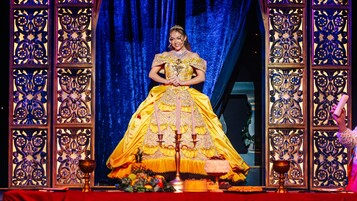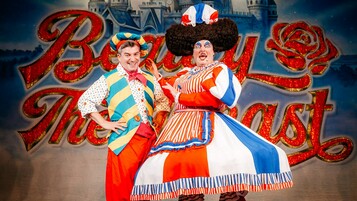News Story
Pantomime is as much a part of Great Britain as cups of tea, bright red buses and fish and chips, but where did it come from and how has it developed over this time. Here we’re exploring the beginnings of pantomime and how it has developed over the centuries to become the fantastic spectacle we enjoy every Christmas.
The origins of panto
The roots of pantomime trace all the way back to the Italian theatre movement, “commedia dell’Arte”. This 16th century Italian entertainment experience combined dance, music, tumblers, acrobats and a specific cast of recognisable stock characters who charmed and entertained audiences around Italy. The main character to come from commedia dell’Arte include Harlequin, Scaramouch, Pierrot, Punch, Pantaloon and the romantic character of the group, Columbine. Each of these characters became immediately recognisable and by the beginning of the 18th century these characters from the Italian theatre began arriving on the stages of London.
The earliest pantomimes used only music, with no speech, and told many classic stories and fairy tales. Harlequin was the star of the pantomime in the 18th century. The character with a scoundrelesque personality, patched up clothing and quick wits won the hearts of audiences and became a firm favourite with the London theatre audience. John Rich became known as one of the earliest UK Harlequins and he built Covent Garden Theatre in 1732 with the aim of showing his Harlequin pantomimes as often as possible. Rich also created the Harlequinade which saw the lovers Harlequin and Columbine kept apart by Pantaloon, the girl’s father and his servant, Clown. The fun, slapstick style comedy developed in the Harlequinade was at the heart of almost all 18th century pantomime but it didn’t stop there.
Shocking regular theatre goers and doing something a little different, actor David Garrick took a speaking Harlequin to Drury Lane Theatre. Garrick worked with writers to create original and fun versions of traditional folk and fairy tales, written with the stage in mind. It was also at this time that Joseph Grimaldi came to fame and his portrayal of Clown became even more popular than Harlequin in some circles.
Once the 19th century arrived theatricality was coming to a head with elaborate scenes and fun effects becoming as much a part of the show as the acting.
Innovation and Invention in the Victorian Pantomime
The Theatres Act in 1843 revolutionised theatre and pantomime in England, as it removed restrictions on spoken word on stage. It allows any theatre without a royal patent to produce plays using only spoken word and this meant puns, word play and of course audience participation could now flourish during pantomimes. The classic art of mime and slapstick were not forgotten but they were expanded and built upon with the wonder of words.
Pantomimes had the clever advantage of being essential fun and made up nonsensical fairy tales and magical stories. This allowed writers to throw in pretty much any topic from politics to satire and get even more laughs. You’d find shows switching from fairy tale familiarity to current events such as the innovative but not yet 100% safe railways and steam trains.
By the end of the 19th century the pantomime was a huge event, with hours spent on stage and audiences enjoy whole days of entertainment from many leading stars. Customary shows on Boxing Day created the intrinsic link between Panto and Christmas, something we always celebrate today. Toy theatres and puppet shows became hugely popular Christmas gifts and presents for young children as the magic of theatre had well and truly taken hold across England.
Swapping and changing: why role reversal is so intwined with panto
The theatrical device of gender reversal is a vital part of what makes pantomime so appealing. It became commonplace in the Victorian era and has stuck around ever since. Women playing principal boys came as early as 1837. In this era women were expected to maintain their modesty and even cover their ankles in public, so young women dressed in trousers or even shorts was a risqué and controversial move, bringing even more interest and intrigue to the world of panto. The female principal boy was a convention of pantomime by the late 19th century and has remained so ever since.
While women were absent from the stage from centuries, men have always played a range of roles. Before women could be actors, men had to play the female roles and this led the development of the outrageous and beloved parody characters like our favourite dames. Men were playing dames as early as 1806, with Samuel Simmons and his Mother Goose role. The dame’s not-quite-hidden masculinity is central to the gag and as the years have gone by, so has the absurdity and the extremities of the costumes worn by dames. Widow Twankey is a character created just for pantomime and the story of Aladdin. H.J. Bowers created the character in 1861 and after Twankey, scores of men found their calling at Christmas and built whole careers around being pantomime dames.
Where do they get their stories?
We recognise most of the pantomime stories from fairy tales and children’s books, but traditional pantomime has taken its inspiration from all kinds of different sources. Dick Whittington, for example, is one of the most beloved pantomime stories of all time. This story is based in fact, and the real life of a former London mayor who died in the 13th century. The fantastical stories taken to the stage are part-based on written accounts of his life, such as Thomas Heywood's 1656 The Famous and Remarkable History of Sir Richard Whittington. However, there is not one account of Dick Whittington that suggests he ever owned a cat!
Most of the time the stories are recognisably linked to common fairy tales and nursery rhymes. Many of the characters are made more fantastical and others have their own unique plot, but often the base stories are ones we know well and recognise with warmth from childhood.
A celebration of spectacle and illusion
Once the British love for pantomime was at its peak, stage managers and producers look for the most fantastic and spectacular ways to make their show stand out. Pantomime came to be focused on elaborate set designs and early special effects. Hinged flaps, flying systems, trapdoors and pivots would be cleverly positioned around the stage to create illusions and amazing acts of spectacle and theatre. The behind the scenes teams did amazing work, doing all they could with lights, the basic technology available to them and effects such as coloured silks, gauzes and glass to evoke ghostly fogs and mists. Theatres first had gaslight in 1817 and electricity arrived at the Savoy Theatre in 1881. Stage machinery became commonplace in the largest theatres and stage designers were revered for their genius, often appearing in the illustrated press with their latest contraptions and inventions.
By 1900 pantomimes truly were an epic spectacle. Records show the 1900 production of Sleeping Beauty and the Beast took the stage show to new levels. Not only were two different stories combined in a fascinating way, it became known as one of the most lavish shows of all time. The combination of two stories meant double the number of scenes and hours and hours of performances, keeping audiences hooked.
20th and 21st century pantomime
Pantomime of the modern day remains as beloved and enjoyed as it ever was. Throughout the last century there have been many well-known stars who have boosted their career with a spot in panto. Faces such as Cilla Black and Bonnie Langford popped up as principal boys in the beginning of their careers and unforgettable dames such as Paul O’Grady and Biggins never fail to draw in the crowds.
The stories, techniques and characters we love in the modern pantomime date back at least a couple of hundred years, if not longer, and it’s fascinating how such an old artform continues to be popular and attracts sell-out audiences today. The pantomime is as important to Christmas as turkey and stockings and it’s something we will continue to enjoy for many years to come.
© Content provided by Blackpool Grand Theatre & UK Productions Ltd.



